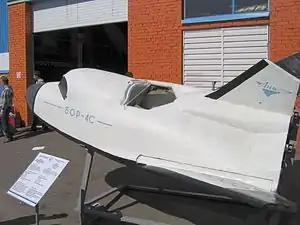BOR-4
The BOR-4 (БОР-4 Russian: Беспилотный Орбитальный Ракетоплан 4, Bespilotnyi Orbital'nyi Raketoplan 4, "Unpiloted Orbital Rocketplane 4") flight vehicle is a scaled (1:2) prototype of the Soviet Spiral VTHL (vertical takeoff, horizontal landing) spaceplane. An uncrewed, subscale spacecraft, its purpose was to test the heatshield tiles and reinforced carbon-carbon for the Buran space shuttle, then under development.[1]
| BOR-4S | |
|---|---|
 | |
| BOR-4S nº401 at MAKS Airshow in Zhukovskiy, 2005 | |
| Role | Uncrewed 1:2 scale re-entry test vehicle |
| National origin | Soviet Union |
| First flight | 5 December 1980 |
| Number built | 7 |
Several of them were built and flown between 1982 and 1984 from the Kapustin Yar launch site at speeds of up to Mach 25. After reentry, they were designed to parachute to an ocean splashdown for recovery by the Soviet Navy. The testing was nearly identical to that carried out by the US Air Force ASSET program in the 1960s, which tested the heatshield design for the X-20 Dyna-Soar. On 16 March 1983[2]: 207 a Royal Australian Air Force P-3 Orion reconnaissance aircraft captured the first Western images of the craft as it was recovered by a Soviet ship near the Cocos Islands.[3]
Flights
Seven BOR were built, and four confirmed flights took place:[4][5]
- n/a – 5 December 1980 – BOR4S nº401 - suborbital flight
- Cosmos-1374 – 4 June 1982 – BOR4 nº404 – orbital flight, splashed down into the Indian Ocean. Orbit: 158 x 204km. Inclination: 50.7 degrees. Weight: possibly about 1 tonne. Number of orbits: 1.[2]: 207
- Cosmos-1445 – 15 March 1983 – BOR4 nº403 – orbital flight, splashed down into the Indian Ocean.
- Cosmos-1517 – 27 December 1983 – BOR4 nº405 – orbital flight, splashed down into the Black Sea.
- Cosmos-1614 – 19 December 1984 – BOR4 nº406 – orbital flight. Orbit: 176 x 223 km. Inclination: 50.7 degrees. Weight: possibly 1 tonne. Recovered after splashed down in the Black Sea.[2]: 208
Current locations
- BOR-4S nº401 – Zhukovsky, Moscow Oblast, Russia[6]
- BOR-4 – Zhukovsky, Moscow Oblast, Russia[6]
References
- Grayzeck, Edwin.J. "NASA - National Space Science Data Center - Spacecraft - Details: Cosmos 1517". NSSDC Master Catalog. National Aeronautics & Space Administration. Archived from the original on 19 December 2022. Retrieved 16 January 2015.
- Turnill, Reginald, ed. (August 1987). Jane's Spaceflight Directory. Jane's Information Group. ISBN 0710608381.
- Hodges, Jim (23 June 2011). "They're Trying to Make a Dream Come True". The Researcher News. NASA Langley Research Center. Archived from the original on 3 May 2022.
- Petrovitch, Vassili. "BOR Characteristic". buran-energia.com. Archived from the original on 28 September 2022. Retrieved 12 February 2016.
- Bauduin, Pierre (3 March 2007). "Unmanned Orbital Rocket Planes type "BOR"". Weebau Spaceflight Encyclopedia. Archived from the original on 16 January 2021. Retrieved 12 February 2016.
- "BOR: Où les voir ?" [BOR: Where to see them?]. kosmonavtika (in French). Archived from the original on 23 January 2021. Retrieved 12 February 2016.